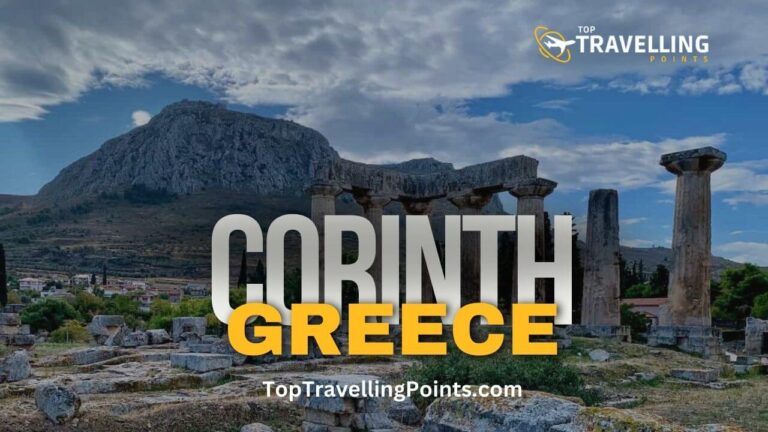Sparti, Greece: History, Population, Landmarks, and Facts
Sparti, located in the picturesque region of the Peloponnese in Greece, is not just a modern city but a treasure trove of ancient history and cultural significance. As the capital of the Laconia prefecture, this city nestled on the banks of the Eurotas River, approximately 22 kilometers from the coast, offers an enticing blend of history, a contemporary population, and iconic landmarks that harken back to its days as the mighty city-state of Sparta.
Sparti History
Sparta, established by the Dorians in the 10th century BC, rose to become one of the most powerful and influential city-states in ancient Greece. This was largely attributed to its unwavering commitment to military excellence and rigorous physical training. Spartan warriors gained notoriety across the ancient world for their exceptional bravery and battlefield prowess.
Sparta’s indomitable spirit played a pivotal role in the Greco-Persian Wars, immortalized by their heroic stand at the Battle of Thermopylae in 480 BC, a defining moment in Greek history. Sparta’s influence extended to the Peloponnesian War, where it ultimately triumphed over Athens in 404 BC.
Nonetheless, Sparta’s supremacy experienced a decline after its defeat by Thebes at the Battle of Leuctra in 371 BC, and it never fully recovered. The city retained its independence until the 2nd century BC when it fell to the Romans, marking a turning point in its history.
Recommended: Kalamata, Greece
Sparti Population
Present-day Sparti boasts a population of approximately 36,000 residents. The majority of the population identifies as Greek, but there is also a modest minority of immigrants from neighboring countries such as Albania and Bulgaria, adding to the city’s multicultural fabric.
Recommended: Rethimno, Greece
Sparti Landmarks
Reliving Ancient Glory:
Sparti offers visitors a chance to step back in time with its array of significant archaeological sites and historical landmarks:
- Ancient Sparta: The ruins of ancient Sparta are located on the city’s outskirts. Here, visitors can explore remnants of the acropolis, the theater, the temple of Artemis, and various other structures that once defined Spartan civilization.
- Menelaion: Situated approximately 4 kilometers from Sparti, the Menelaion is a sanctuary dedicated to Menelaus, the mythical king of Sparta. It stands as one of the most remarkable archaeological sites in the Peloponnese, echoing the rich tapestry of Greek mythology.
- Leonidas Monument: In the heart of Sparti’s main square stands a bronze statue commemorating Leonidas, the Spartan king who led the Greeks to victory at the Battle of Thermopylae, etching his name in the annals of history.
Additionally, Sparti features the Byzantine Museum, the Archaeological Museum, and the Church of the Holy Apostles, each contributing to the city’s cultural and historical wealth.
Recommended: Heraklion, Greece
Sparti Facts
Unveiling Unique Tidbits:
Here are some captivating facts about Sparti:
- Olympic Games’ Birthplace: The city is closely linked to the birth of the Olympic Games, the world’s oldest athletic competition. The inaugural Games took place in Olympia, a city approximately 40 kilometers from Sparti, in 776 BC.
- Ancient Olive Tree: Sparti is home to the world’s oldest olive tree, which has thrived for over 3,000 years and still produces olives to this day, a living testament to the city’s enduring legacy.
- The “Spartan” Descriptor: The English word “Spartan” derives from the name of Sparta, reflecting simplicity, austerity, and severity, mirroring the traits of its ancient inhabitants.
In conclusion, Sparti is a city deeply intertwined with history and culture. Its unique blend of ancient heritage and contemporary life, along with its inviting people and delightful cuisine, makes it a must-visit destination for travelers eager to explore the heart of ancient Greece.
Sparti FAQs
Q: What is the best time to visit Sparti?
A: The ideal times to explore Sparti are during the mild seasons of spring (April to June) and autumn (September to October). Summers can be scorching, while winters tend to be cold and rainy.
Q: How do I get to Sparti?
A: Sparti boasts excellent connectivity through buses and trains, ensuring seamless travel from various parts of Greece. There is also a small airport in Sparti, although it primarily serves a limited number of major Greek cities.
Q: What are the must-see attractions in Sparti?
A: Key attractions include the ancient ruins of Sparta, the Menelaion, and the Leonidas Monument. Visitors should also make time for the Byzantine Museum, the Archaeological Museum, and the Church of the Holy Apostles to delve deeper into the city’s heritage.
Q: What is the food like in Sparti?
A: Sparti offers a delectable array of traditional Greek cuisine, including dishes such as moussaka, souvlaki, and gyros. The city is renowned for its high-quality olive oil and honey.
Q: What are some things to do in Sparti besides visiting historical sites?
A: The beautiful surrounding area of Sparti is perfect for activities like mountain hiking, Mediterranean Sea swimming, and exploring the charming nearby villages and towns.
DID WE MAKE A MISTAKE?
Submit a correction suggestion and help us fix it!
- Exploring Ohio: Unveiling the Gems of the Buckeye State - May 11, 2024
- Exploring the Ancient Marvel: Corinth, Greece - May 8, 2024
- Discover Acharnes: Where Ancient History Meets Modern Vitality - May 8, 2024







